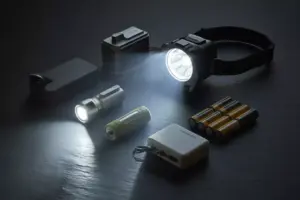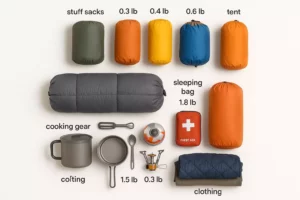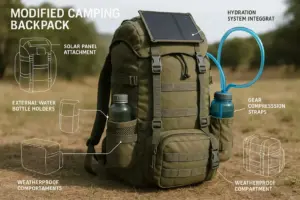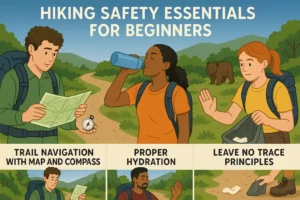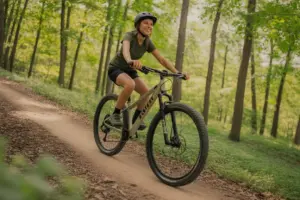Family Camping on a Budget: Best Value 6-Person Tents
Picture this: your family gathered around a crackling campfire, sharing stories under a blanket of stars, while your trusty tent stands ready to provide comfort and protection—all without breaking the bank. Family camping doesn’t have to drain your savings account, especially when you make smart choices about your most important piece of gear: the tent.
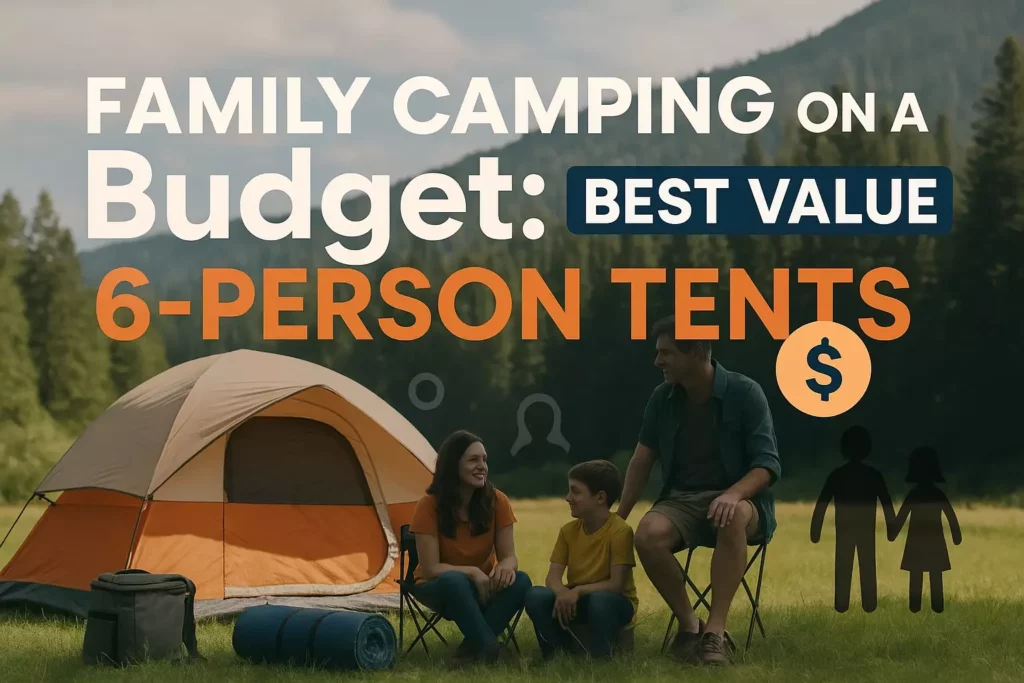
Finding the perfect 6-person tent that balances quality, space, and affordability can feel overwhelming with hundreds of options flooding the market. The good news? You don’t need to spend a fortune to create lasting memories in the great outdoors.
Key Takeaways
- Budget-friendly 6-person tents can provide excellent value without sacrificing essential features like weather protection and durability
- Look for key features including waterproof ratings of 2000mm+, sturdy pole construction, and adequate ventilation systems
- Smart shopping strategies like buying during off-season sales and considering slightly used gear can save 30-50% on quality tents
- Proper tent care and maintenance can extend the life of budget tents by 3-5 years, maximizing your investment
- Consider total camping costs beyond just the tent—budget tents allow more money for other essential gear and experiences
Understanding 6-Person Tent Sizing and Space
Before diving into specific recommendations, it’s crucial to understand what “6-person” actually means in tent terminology. Most 6-person tents comfortably sleep 4 adults or 2 adults with 3-4 children, providing adequate space for sleeping bags and minimal gear storage.
Realistic Space Expectations
Floor space in quality 6-person tents typically ranges from 90-120 square feet. This translates to:
- 4 adults: Tight but manageable sleeping arrangement
- 2 adults + 3 kids: Comfortable family setup
- 2 adults + 2 kids: Spacious with room for gear storage
Peak height varies significantly, with budget options ranging from 5’8″ to 6’6″. Taller family members should prioritize models with center heights of 6’2″ or more for comfortable movement inside the tent.
Essential Features to Prioritize in Budget 6-Person Tents
Weather Protection 🌧️
Waterproof rating should be your top priority. Look for tents with:
- Rainfly: Minimum 2000mm waterproof rating
- Floor: 3000mm+ rating for ground moisture protection
- Sealed seams: Factory-sealed or include seam sealer
Ventilation Systems
Poor ventilation leads to condensation buildup, making budget tents feel clammy and uncomfortable. Essential ventilation features include:
- Multiple mesh windows with storm flaps
- Roof vents or mesh panels near the peak
- Ground-level vents for air circulation
Pole Construction and Stability
Budget tents often compromise on pole quality, but certain materials offer better value:
- Fiberglass poles: Cheapest option, adequate for calm weather
- Steel poles: Heavier but more durable than fiberglass
- Aluminum poles: Best strength-to-weight ratio, worth the small price increase
Top Budget-Friendly 6-Person Tent Categories
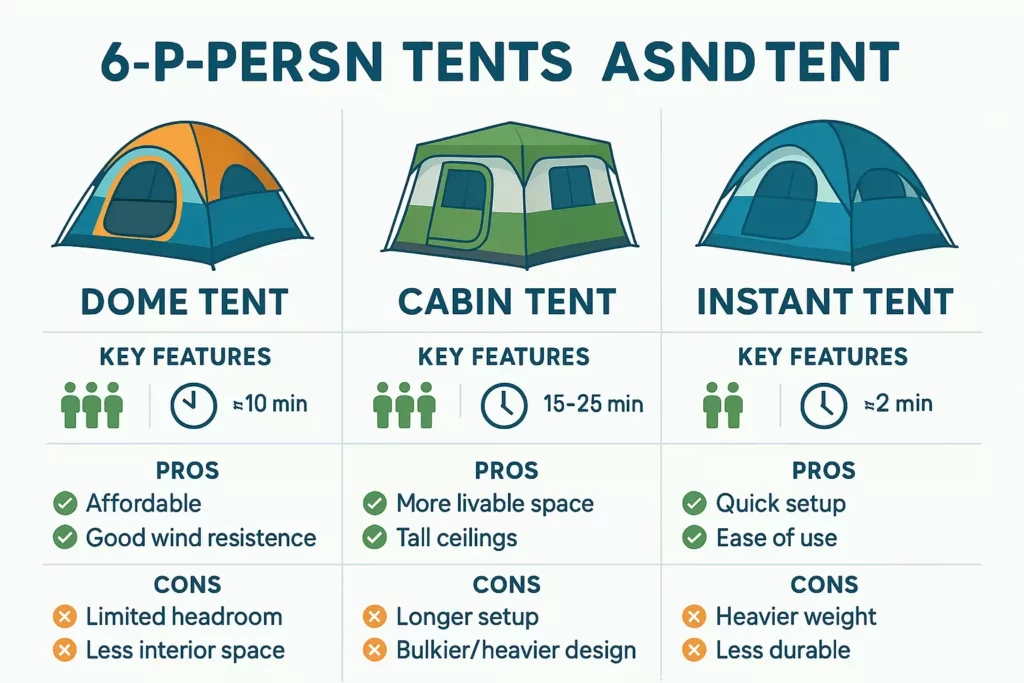
Dome Tents: Maximum Stability
Dome-style tents offer excellent wind resistance and easier setup, making them ideal for families new to camping. The curved structure distributes wind load effectively, reducing the risk of collapse during storms.
Pros:
- Superior wind resistance
- Simpler setup process
- More headroom in center area
Cons:
- Less floor space than cabin tents
- Limited straight walls for gear organization
Cabin Tents: Maximum Space
Cabin tents provide vertical walls and maximum interior space, perfect for families who prioritize comfort and storage. These rectangular structures offer more livable space but require careful site selection.
Pros:
- Maximum floor space utilization
- Easier to organize gear and sleeping areas
- Often include room dividers
Cons:
- More susceptible to wind damage
- Longer setup time
- Requires level ground
Instant Tents: Maximum Convenience
Instant or pop-up tents feature pre-attached poles that allow setup in under 5 minutes. While slightly more expensive initially, they save time and frustration, especially valuable when camping with kids.
Smart Shopping Strategies for Maximum Value
Timing Your Purchase 📅
End-of-season sales (September-November) offer the best discounts, with retailers clearing inventory for winter. You can often find 40-60% discounts on quality tents during this period.
Spring clearance events (March-April) provide another opportunity as stores make room for new models.
Where to Find the Best Deals
Online retailers often offer better prices than brick-and-mortar stores, but consider these factors:
- Return policies: Ensure you can return the tent if it doesn’t meet expectations
- Shipping costs: Factor into total price comparison
- Customer reviews: Read recent reviews focusing on durability and weather performance
Warehouse stores like Costco occasionally offer excellent tent values, though selection may be limited.
Considering Used and Refurbished Options
Gently used tents can provide exceptional value, but inspect carefully for:
- Fabric tears or holes
- Zipper functionality
- Missing stakes or guylines
- Pole damage or bending
🏕️ Family Camping Budget Calculator
Budget Tent Maintenance for Longevity
Proper Setup and Takedown
Careful setup extends tent life significantly. Always:
- Clear the ground of rocks, sticks, and sharp objects
- Use a footprint or tarp under the tent floor
- Avoid over-tensioning guylines and stakes
- Allow fabric to relax before final adjustments
Cleaning and Storage Best Practices
Regular cleaning prevents mold, mildew, and fabric degradation:
- Spot clean immediately after camping trips
- Deep clean annually with mild soap and water
- Dry completely before storage to prevent mold
- Store loosely in a large storage bag, not the original stuff sack
Repair and Maintenance Tips 🔧
Small repairs can prevent major problems:
- Seam sealing: Reapply every 2-3 years or as needed
- Zipper maintenance: Clean and lubricate with zipper wax
- Patch holes: Use tent repair tape or patches immediately
- Pole care: Check for cracks and replace damaged sections
Keeping a well-stocked first aid kit isn't just for family safety—include tent repair supplies for gear emergencies.
Maximizing Your Camping Budget Beyond the Tent
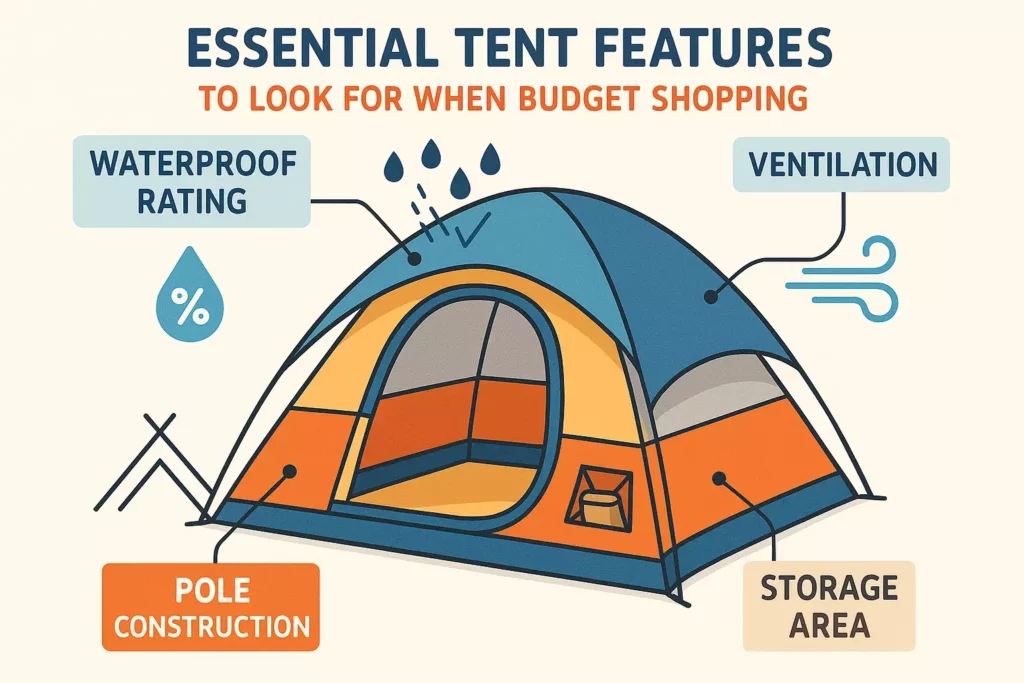
Essential Gear Prioritization
With your tent secured, allocate remaining budget wisely:
High Priority Items:
- Quality sleeping bags - See our guide on how to pick a sleeping bag
- Reliable lighting - Headlamps and lanterns
- Cooking equipment - Portable stove and cookware
- Weather protection - Check our cool weather clothes guide
Medium Priority Items:
- Camping chairs - Comfort for longer trips
- Cooler - Food safety and convenience
- Shelter accessories - Tarps and rope
Money-Saving Camping Strategies
Borrow or share gear with friends and family for expensive items used infrequently. Many camping enthusiasts are happy to lend gear to encourage others to enjoy the outdoors.
Start with car camping to reduce gear requirements. You don't need ultralight equipment for campground adventures, allowing focus on comfort and value rather than weight savings.
Cook your own meals instead of relying on camp stores. Learn campfire cooking basics to save money and enhance the camping experience.
Safety Considerations for Budget Camping
Weather Preparedness
Budget tents require extra weather vigilance. Monitor forecasts closely and have backup plans for severe weather. Consider these safety measures:
- Backup shelter options like a tarp or vehicle access
- Emergency communication devices for remote areas
- Weather radio for storm warnings
- Evacuation plan if tent fails during severe weather
Site Selection Importance
Proper campsite selection becomes critical with budget gear:
- Level ground reduces stress on tent floors and poles
- Natural windbreaks protect from strong gusts
- Drainage considerations prevent water pooling during rain
- Distance from hazards like dead trees or rocky slopes
For families new to camping, our comprehensive camping with kids guide covers essential safety considerations.
Creating Memorable Experiences on a Budget
Focus on Activities, Not Gear
The best family memories come from shared experiences, not expensive equipment. Budget camping allows more resources for:
- State park fees and entrance costs
- Activity equipment like fishing gear or bikes
- Local attractions and educational opportunities
- Special treats like s'mores supplies and camp games
Building Camping Skills
Budget gear teaches valuable skills that enhance outdoor confidence:
- Problem-solving when equipment has limitations
- Weather awareness and adaptation strategies
- Maintenance skills for gear longevity
- Resourcefulness in challenging situations
Explore our family camping activities guide for budget-friendly entertainment ideas.
Long-Term Value and Upgrade Paths
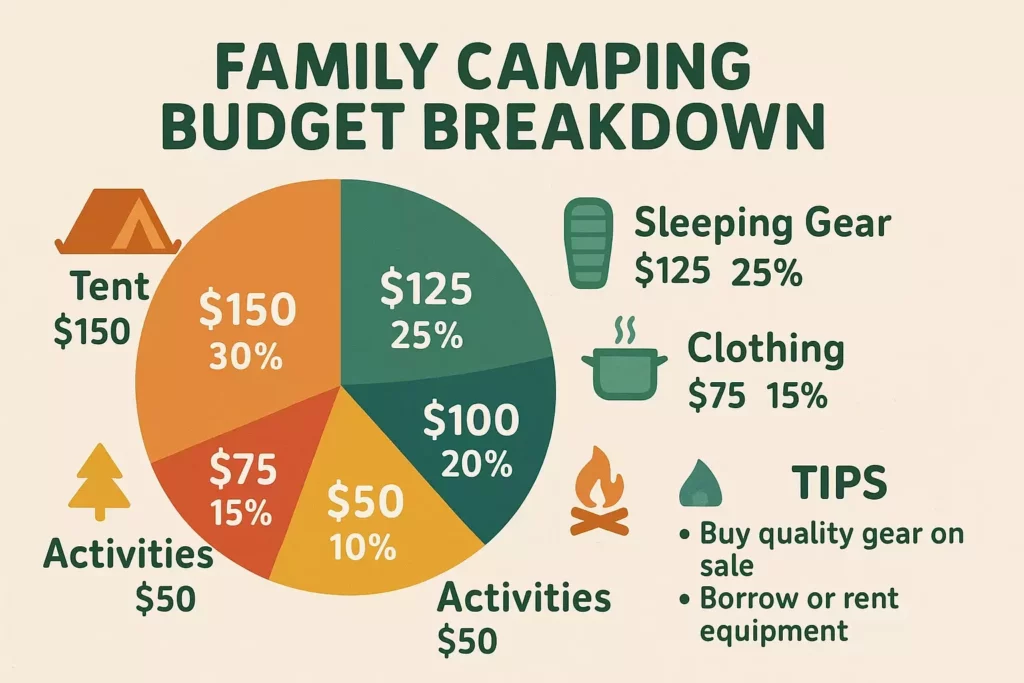
When to Upgrade Your Tent
Signs it's time for a new tent:
- Frequent repairs becoming necessary
- Comfort issues affecting sleep quality
- Family size changes requiring more space
- Activity evolution toward different camping styles
Building a Camping Gear System
Smart budget camping involves building a complete system over time:
Year 1: Focus on shelter, sleeping, and basic cooking
Year 2: Add comfort items and specialized gear
Year 3: Upgrade key items based on experience
This approach spreads costs while allowing informed decisions based on actual camping experience.
Teaching Kids Outdoor Values
Budget camping teaches children important lessons:
- Resourcefulness and making do with what you have
- Environmental awareness and leaving no trace
- Family cooperation and shared responsibilities
- Appreciation for simple pleasures and nature
Advanced Budget Camping Tips
Seasonal Camping Strategies
Different seasons offer unique budget opportunities:
Spring camping provides mild weather perfect for testing new gear, while fall camping offers comfortable temperatures and beautiful scenery without summer crowds.
Winter camping in mild climates can provide exceptional value at normally expensive destinations, though gear requirements increase significantly.
Group Camping Economies
Camping with other families creates cost-sharing opportunities:
- Shared meal preparation reduces individual food costs
- Group gear purchases for items like large tarps or camp kitchens
- Bulk buying of consumables like firewood and ice
- Shared transportation to reduce travel costs
DIY Gear and Modifications
Simple modifications can improve budget tent performance:
- Additional guylines for improved stability
- Reflective emergency blankets for extra floor insulation
- Battery-powered fans for improved ventilation
- Gear lofts created from mesh storage bags
Learn more about packing efficiently to maximize your tent's usable space.
Emergency Preparedness on a Budget
Essential Safety Gear
Budget camping requires extra safety preparation:
- First aid supplies tailored to your family's needs
- Emergency shelter like space blankets or bivvy sacks
- Water purification methods - see our water purification guide
- Communication devices for emergency contact
Backup Plans and Alternatives
Always have contingency plans:
- Nearby accommodations identified before departure
- Alternative campsites in case of closures or weather
- Gear redundancy for critical items like lighting and warmth
- Early exit strategies if conditions become unsafe
Environmental Responsibility and Budget Camping
Leave No Trace Principles
Budget camping shouldn't mean environmental compromise:
- Proper waste disposal protects natural areas
- Campfire safety prevents wildfires and damage
- Wildlife protection through proper food storage
- Trail and campsite preservation for future visitors
Sustainable Camping Practices
Long-term environmental thinking saves money and protects camping opportunities:
- Reusable items instead of disposables
- Local sourcing of firewood and supplies
- Minimal impact camping techniques
- Education and advocacy for outdoor access
For comprehensive outdoor skills, explore our bushcraft survival kit guide for budget-friendly preparedness ideas.
Conclusion
Family camping on a budget doesn't require sacrificing safety, comfort, or fun—it simply demands smarter choices and realistic expectations. The perfect 6-person tent for your family balances essential features like weather protection and durability with your financial constraints, allowing more resources for creating lasting memories in the great outdoors.
Remember that the most expensive tent won't guarantee the best camping experience. Focus on understanding your family's specific needs, shopping strategically for maximum value, and maintaining your gear properly to extend its useful life. Whether you choose a basic dome tent under $100 or invest in a mid-range cabin tent around $300, the key is selecting gear that will reliably shelter your family while you build outdoor skills and confidence together.
Start planning your next family camping adventure today. Research campgrounds in your area, check seasonal weather patterns, and begin building your gear collection gradually. Most importantly, remember that the goal isn't perfect equipment—it's quality time together in nature, learning new skills, and creating stories you'll share for years to come.
Your budget camping journey begins with a single trip. Choose your tent wisely, pack your sense of adventure, and discover that some of life's best experiences come not from spending more money, but from spending more time together outdoors.

